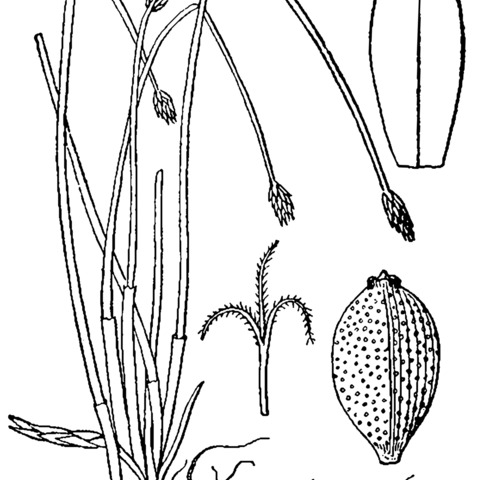Plants perennial, mat-forming; rhizomes evident, short to rather long, 2–3 mm thick, firm, cortex persistent, internodes very short to 2 mm, scales often decaying to coarse fibers, 5–12 mm, papery. Culms subterete to greatly compressed, to 5 times as wide as thick, often with 2–12 ridges, 8–45 cm × (0.2–)0.5–1.8 mm, firm to hard, spongy. Leaves: distal leaf sheaths persistent, not splitting, proximally red, distally green to stramineous, papery, apex usually red-brown, broadly obtuse to sub-truncate, callose, tooth absent. Spikelets ovoid, 4–8 × 2–4 mm, apex acute; proximal scale clasping 3/4 of culm to amplexicaulous, entire; subproximal scale empty or with flower; floral scales spreading in fruit, 20–60, 6 per mm of rachilla, medium brown to very dark brown, sometimes stramineous or colorless, midrib region often paler, ovate, 2–3(–4) × 1–1.5 mm, apex acute to acuminate, the apical colorless hyaline region mostly longer than wide and 0.6–1.2 mm, in proximal part of spikelet 2-fid to shallowly cut, rarely entire, in distal part often entire, carinate in distal part of spikelet. Flowers: perianth bristles 0–5, stramineous, length variable, to equaling achene, obscurely to clearly retrorsely spinulose; stamens 3; anthers yellow-to orange-brown, 0.7–2 mm; styles 3-fid or some 2-fid. Achenes falling with scales or some persistent, yellow-brown or dark brown, obovoid to obpyriform, nearly equilaterally to compressed-trigonous or usually some biconvex, angles evident or obscure, 0.8–1.1 × 0.6–0.8 mm, neck very short, finely rugulose and sometimes finely (or coarsely) cancellate at 10–20X with 14–20 blunt horizontal ridges in a vertical series. Tubercles brown (to whitish), pyramidal, usually depressed, often rudimentary, 0.15–0.3 × 0.2–0.35 mm.
More
Stems slender, compressed and often twisted, with 9–14 vascular bundles; scales lance-ovate, prolonged into a scarious acuminate tip, often bifid or lacerate in age; achene golden to brown, 1–1.5 mm; tubercle depressed to rounded-conic; 2n=18, 20, 24, 36; otherwise much like no. 14 [Eleocharis tenuis (Willd.) Schult.]. Marshes and shores; Ont. to Sask., s. to Ga. and Tex. (E. acuminata) Passes into E. tenuis var. borealis


